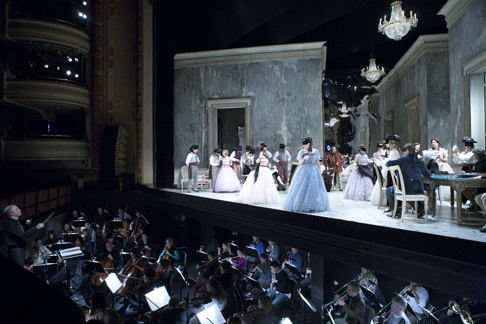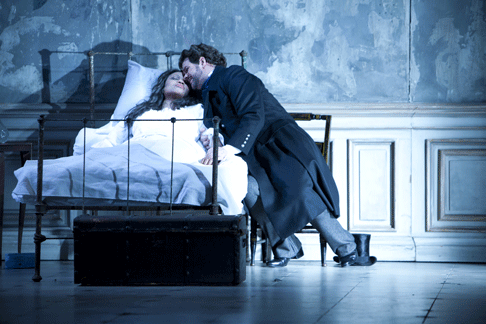Apparently, what began as a joint venture between the Metropolitan Opera and the New York Philharmonic turned into a triple endeavor when the well-known conductor Julius Rudel, then the head of New York City Opera, decided to join the group, bringing City Opera from City Center to its new location in what was then the New York State Theater.
This greatly perturbed Bing, and his fears had a sound
basis in elementary economics. After all, he reasoned, if two opera companies
that are quite literally adjacent to each other are performing La
Traviata, one for twenty dollars a ticket and the other for ten dollars a
ticket, it’s fair to guess that the company selling ten dollar tickets
would get better box office receipts.
That’s not exactly what happened. It is a sad fact of the history of
“the people’s opera” that the company has perennially
suffered from faulty management, both where financial and artistic matters are
concerned. What’s more, City Opera management has spent decades trying to
produce a product with the caliber of the Metropolitan Opera while lacking the
Met’s monetary resources. Unfortunately, the company’s general
directors in the post-Sills era have not been possessed of the fundraising
talents that were almost innate in America’s operatic darling.
As far as the company’s artistic actions are concerned, City Opera has
fared none the better. It should be no surprise if this statement brings names
like Susan Baker, George Steel, and Gerard Mortier to mind. Susan Baker, a
former Goldman Sachs executive, was elected to the post of Chief of the Board
of Directors in 2004. While she might have had the financial sense, according
to an article in Opera News by Fred Cohn, she managed to successfully
involve herself in the company’s artistic procedures without much
knowledge of how the artistic decisions of an opera company are made. Her
largest faux pas in recent history was to entice Gerard Mortier, who
was at the time finishing his tenure with the Paris OpÈra, to come to New York
after his contract in Paris ended in 2009 to head the company on Paul
Kellogg’s retirement.
Gerard Mortier is one of the opera world’s major movers and shakers.
He is a tireless promoter of modern works and edgy interpretations.
Unfortunately, by the time Susan Baker contacted him, he was too used to
working in Europe where arts organizations receive government subsidy. At this
point, NYCO was already suffering from the deleterious effects of performing
opera in the New York State Theater, a theater that was more suited to the New
York City Ballet, which shared operations with NYCO. Instead of encouraging the
company to look for a new theater, Mortier insisted that they renovate their
own. This led to a multi-million dollar renovation, spearheaded by David H.
Koch, for whom the theater is now named.
Unfortunately, due to the renovations, the company lost an entire season,
except for one performance of Samuel Barber’s Antony and
Cleopatra at Carnegie Hall. In this light, it is obvious to see why Mr.
Mortier, who was planning among other things a staging of Olivier
Messiaen’s St Francis of Assisi at the Park Avenue Armory,
quickly resigned his post. In the scramble to find a new general director, the
company contracted George Steel, someone whose only prior experience in the
opera world was a fourteen-week stint as General Director of Dallas Opera. To
be fair, he had previously turned Columbia University’s Miller Theater
into a household name in the contemporary classical music scene. However, as
both Mr. Steel and New York’s opera-going public soon found out, NYCO is
or at least aspires to be an opera company, something that is far beyond the
desires and monetary means of the Miller Theater.
 Scene from La traviata
Scene from La traviata
Also, as the company’s last season will attest, while it is important
to present works of contemporary fare, such as Leonard Bernstein’s A
Quiet Place, it is important to do so in a way that does not alienate the
majority of the public, who at least at this point are interested in standard
fare. Looking back on last season, it seems as if Donizetti’s The
Elixir of Love is the only standard rep opera the company performed.
Therefore, despite last season’s critical success, the company suffered a
major blow at the box office.
This is why the company’s new production of La Traviata,
directed by Jonathan Miller, is so important. Due to financially induced labor
disputes, as well as the firing of many important personnel, such as the
company’s Music Director George Manahan, NYCO, whose glorious past
includes performers like Sills, Domingo, Ramey, as well as operas such as
Moses und Aron, Die Soldaten, Giulio Cesare, and
Donizetti’s Three Queens trilogy, now finds itself facing the
need to prove itself as viable in New York’s — to say nothing of
America’s — cultural landscape.
As a fervent believer in City Opera, I would be lying if I said I
didn’t want them to succeed when La Traviata, the first of a
four opera traveling season to take place in various locations in New York
City, opened last week at the Brooklyn Academy of Music. This season, which
also includes Telemann’s Orpheus, Mozart’s CosÏ fan
tutte, and the new opera Prima Donna by singer-songwriter Rufus
Wainwright, demonstrates the opera company’s versatility. Unfortunately,
as the previous sentence stipulates, that characteristic exists only in theory.
It pains me to write that this rendition of Verdi’s great masterwork was
one of the most tepid I have ever experienced.
As the soprano and tenor leads, Laquita Mitchell and David Pomeroy gave
tentative performances at best. Pomeroy, in his debut appearance, had a better
facility with bel canto technique, yet both Mr. Pomeroy and Ms.
Mitchell lacked proper interpretation of text. There are moments in
Verdi’s drawing room thriller that in the right hands crackle with
dramatic tension. By and large, there wasn’t any tension in this
performance at all. Furthermore, Pomeroy seems vocally to be closer to a
tenore leggero, making him more appropriate for the hero of a
Rossinian comedy, as opposed to the tenore di grazia that’s
exemplified by such divos as Carlo Bergonzi or Jonas Kaufmann. As the
performance progressed, Mitchell demonstrated greater ability with bel
canto techniques. Unfortunately, at that point, the lack of dramatic verve
was unfixable. The important thing to understand about Traviata is
that although it is a bel canto opera, and therefore predicated on the
use of such bel canto devices as appogiaturas and
ornamentation, such techniques are used less for displays of vocal virtuosity
and more for dramatic intensification. Furthermore, Traviata’s
libretto can be divided into several key moments. Each moment is dramatically
dependent on those that come before. Therefore, although Ms. Mitchell could be
thrilling, such as in the final ensemble during Flora’s party scene, at
that point, it seemed somewhat irrelevant.
 Laquita Mitchell as Violetta and David Pomeroy as Alfredo
Laquita Mitchell as Violetta and David Pomeroy as Alfredo
As Alfredo’s evil father, who comes between the two lovers, Stephen
Powell, a veteran of NYCO, was exquisite as Giorgio Germont. His voice was
reminiscent of the great early twentieth century baritone Titta Ruffo. Powell
was equally worthy of Ruffo’s nickname, “Il leone” (The
lion). He demonstrated excellent bel canto technique, making his
Germont at once both evil and frighteningly parental.
In the pit, Steven White was at his best in moments of high-powered
orchestral work (I never realized that the score of Traviata was
populated with that many drumrolls). However, despite his facility with strong
pacing, there were moments where his performance was lacking in just that
quality. Such was the case when Alfredo returned in the second scene of Act III
to his dying beloved. The lovers’ frantic embrace, which usually makes
the subsequent waltz “Parigi O Cara” even more heart-wrenching, was
somewhat lackluster. Ironically, his rendition of the overture, which contains
the same waltz tune, was delightful for its almost imperceptible hint of
tension.
If the performers lacked attention to text, Jonathan Miller’s
production is faulty for extreme attention to text. Trained as a physician, his
desire was to portray Traviata in the most literal light possible,
which included a take on Violetta’s tuberculosis that was brimming with
as much verisimilitude as possible. The problem here is that while it is true
consumptives don’t waltz or run around, neither do they sing with what
should be flawless coloratura technique. Miller’s production fails to
understand that people who go to the opera realize that it is not an accurate
depiction of life.
The point of seeing consumptives dying while singing legato lines is not to
see an accurate presentation of someone dying from consumption. Instead, it is
to experience what the consumptive is feeling, something that consumptives in
reality do not have the capacity to fully express at such a time in their
lives. Instead, Miller wanted his Violetta to spend the majority of her time
lying on sofas and settees. While a waltzing or even standing Violetta might be
medically unbelievable, at least it allows for dramatic veracity. During the
confrontation, which occurs at Flora’s party, the moment where Alfredo
throws the money he has won through gambling at Violetta’s feet lost
dramatic veracity because she was unable to react to it with as much strength
as the music allows her.
Lastly, Miller’s production, which is spare and grey, only seemed
ingenious during Violetta’s death scene. Ultra-realistic productions such
as Franco Zeffirelli’s 1999 Met Traviata may have its critics
for its unabashed grandiosity. True, seeing a soprano belt out “Sempre
Libera” while being dwarfed by a gigantic chandelier is comical; however,
the same quality allows the audience to experience the exorbitant conspicuous
consumption of high society in 1830s Paris. It is this conspicuous consumption
that underlines the hypocrisy of the society and forms a major part of the
central conflict. While Miller’s production thankfully has normal-sized
chandeliers, its sets were decrepit and grey, which made it hard to believe
that Parisian high society would dare to be seen in such a place.
Before the opera began, I noticed an energetic young girl and her family
take their seats next to me. Her excitement at the occasion was palpable. She
even brought her own pair of legitimate opera glasses, not the glorified sports
binoculars that are more common nowadays. As the performance progressed, she
busily whispered about it to her father. It was a joy to see such an excited
young opera lover. Seeing her at what was potentially her first opera reminded
me of the early operas I attended. For me, the fun of reminiscing about those
occasions comes from discovering the important people and productions that I
saw without realizing it at the time. Taking her to City Opera was a smart move
on the part of her parents, as the company has a glorious legacy. However, City
Opera still needs to prove that it can hold claim to such a legacy. Let’s
hope it does so by the time she is old enough to appreciate it.
Greg Moomjy
image=http://www.operatoday.com/Traviata_NYCO_01.gif
image_description=Laquita Mitchell as Violetta and David Pomeroy as Alfredo [Photo by Pavel Antonov courtesy of New York City Opera]
product=yes
product_title=Giuseppe Verdi: La traviata
product_by=Violetta: Laquita Mitchell; Flora Bervoix: Karin Mushegain; Alfredo: David Pomeroy; Giorgio Germont: Stephen Powell; Gaston de Letorieres: Jeffrey Halili; Marquis d’Obigny: Krassen Karagiozov; Doctor Grenvil: Kenneth Overton; Baron Douphol: John Maynard; Annina: Jennifer Tiller. Conductor: Steven White. Production: Jonathan Miller. Stage Director and Choreographer: Elena Araoz. Set and Costume Designer: Isabella Bywater. Lighting Designer: Robert Wierzel.
product_id=Above: Laquita Mitchell as Violetta and David Pomeroy as Alfredo
Photos by Pavel Antonov courtesy of New York City Opera